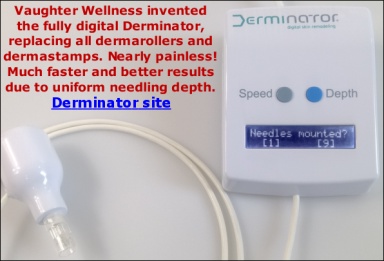I do have a question for you though. How much blood should you see from
Dermarolling? I think the more the better, just as long as it's not
toooooo much? It just seems to me that, if you get more aggressive with the
treatment you would see better results. I.E. Braking up scar tissue,
activating more collagen, creating more blood for new; skin, collagen,
elastin, etc..? What is your advice? I have read conflicting reports but
am not sure which is the best or if it doesn't even matter. Hope all is well! Hi [deleted],
Mild skin injury is a nice trick to make the body renew the skin. When you injure the skin (enough to make a difference and not too much to cause scars), the body will immediately start repairing the damage. This is one of the principles behind certain laser treatments, acid peels, dermabrasion, dermarolling etc.
The advantage of dermarolling compared to those other methods is that it doesn’t remove the outermost layer of skin and there is no danger of burns and other thermal damage.
Wound healing has 3 stages - Inflammation, proliferation and remodeling.
Inflammation is a reaction of our body to heal the injury. More details here:
https://http://forums.owndoc.com/dermarolling-microneedling/How-long-does-the-inflammation-stage-lasts-after-rolling-with-long-needles During the inflammation stage, the blood vessels dilate, resulting in an increased blood flow to the area. The area becomes red and warm. Plasma fluids will flood the area and cause swelling. When the immune system cleans the area of damaged cells, the damaged cells will be replaced by new ones.
The skin consists of 3 layers. The epidermis, the dermis and subdermis.
The epidermis has no blood supply. The dermis has irregular blood vessels and the deeper the dermis the more blood vessels. If you puncture a blood vessel you end up with pinpoint bleeding or even bruises.
The more damage in the dermis you cause, the more remodeling you will get. Nevertheless it is also connected to a higher risk of scarring, infection or hyperpigmentation. For home use, it is much safer to do several rolling sessions with occasional pinpoint bleeding than one "totally bloody" to obtain the same results. Especially if you roll large areas.
If your achieve inflammation (your skin temporarily becoming red after dermarolling), the process of skin renewal has been triggered. That is all you need and you have to regularly repeat it to get results. Your expectations must be realistic. Currently there is no method to completely remove scars, stretch marks, significantly change the pore size or texture of your skin or stop the aging process. A lot of it is determined by hereditary factors. You can achieve improvements though.
We provide single needles that are approx. 2 mm long for deep, intensive targeted treatment of scars or wrinkles. The scar tissue is usually hardened and has to be “crushed” by dense single needling. Single-needling may also release the anchoring of the scar or the wrinkle to the subcutaneous tissue and thus make the scar or wrinkle less indented. You do not (always) have to insert the entire length of the needle (2 to 2.2 mm) into the skin. The full needle length is intended as a safety stop. The skin doesn’t have the same thickness all over the body, neither is the skin precisely identically thick in all individuals.
On a limited-size area such as individual wrinkles or individual stretchmarks or scars, you can go deeper and denser with the single needle and get more pinpoint bleeding. Always do a test patch first to learn what to expect, how much you will bleed, how it heals etc. Make your skin softer by having a hot bath, shower or steaming the face prior needling/rolling and don’t forget to stretch the skin to make it easier for the needle to penetrate.
Related forum posting:
https://http://forums.owndoc.com/dermarolling-microneedling/do-we-need-to-get-that-bloody-to-get-results/



 ?
?
